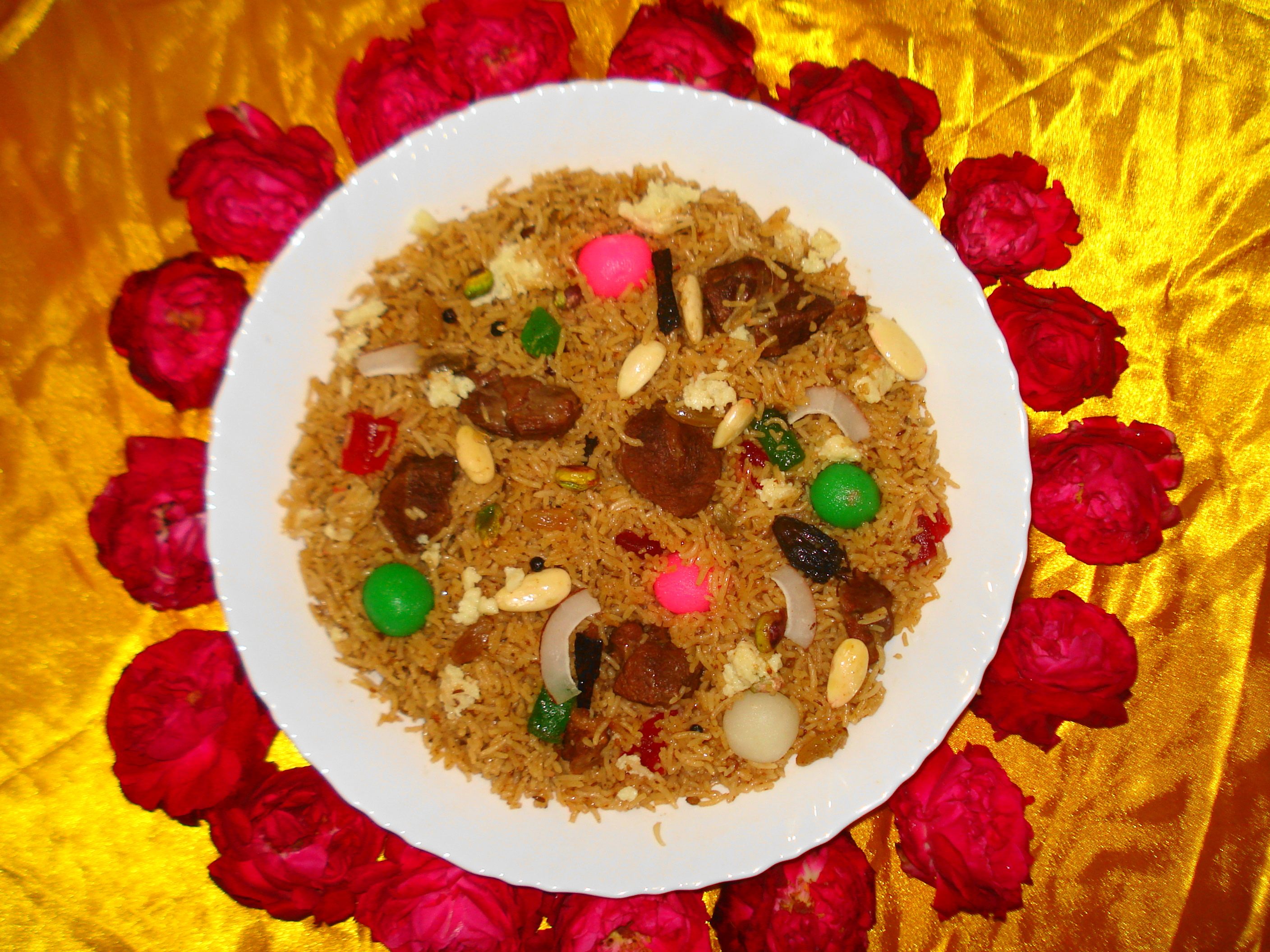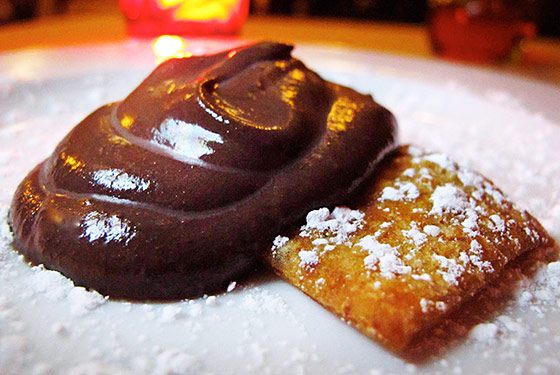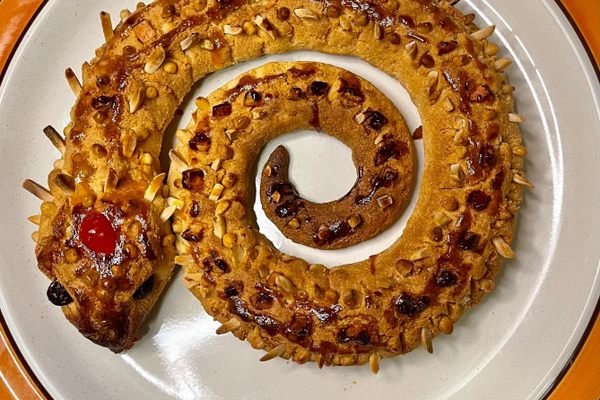Meat-Filled Desserts From Around the World
Have you tried any of these literal sweetmeats?
THIS ARTICLE IS ADAPTED FROM THE APRIL 20, 2024, EDITION OF GASTRO OBSCURA’S FAVORITE THINGS NEWSLETTER. YOU CAN SIGN UP HERE.
This year, I visited Barcelona around Easter, which meant I got to try coca de llardons. This seasonal Catalan pastry, topped with sugar and pine nuts, is made extra decadent with an unusual ingredient: pork cracklings.
I loved the combination of savory and sweet enough that I made my own version as soon as I got home. This got me thinking whether there are other traditional desserts that use animal products in atypical ways. Dairy, eggs, and animal fat are commonplace in sweet dishes: but what about meat?
When you hear “meat dessert,” you might think of boundary-pushing modern experiments like foie gras ice cream. But the use of meat in sweet dishes goes back centuries. In Medieval Europe and the Middle East, when meat, sugar, and spices were all considered luxuries, the upper classes often ate dishes that combined all three. Even today, chefs around the world make recipes that defy modern Western conventions about what does and doesn’t go together: from Moroccan poultry pastilla dusted with powdered sugar, to Vietnamese sausage-and-candied-fruit mooncakes.
When you think about it, it’s not much of a leap from lard in a pie crust to ground meat in a pie filling, or from maple bacon to a maple bacon doughnut. Here are some of the most unique ways that people around the world have meat for dessert.
Khoresh mast
Iran

In Persian cuisine, most khoresht (stews) are savory main dishes served with rice. A notable exception is khoresh mast, meaning “yogurt stew,” which is sweet and may be a side dish, appetizer, or dessert. Meat, typically lamb neck, is used for texture more than flavor.
Chefs cook the meat until tender and separate it from the bones before kneading and pounding it by hand into a doughlike paste. This is blended smoothly with thick yogurt, sugar, rosewater, saffron, and cardamom. The resulting golden-yellow pudding is chilled before serving and garnished with dried fruit and nuts.
Tavuk göğsü
Turkey
In Turkish, tavuk göğsü means “chicken breast,” but it’s also the name for a sweet milky pudding made with that ingredient: primarily for texture, as with khoresh mast. Similar dishes described in the fifth-century Roman cookbook Apicius gave rise to puddings called blancmange or “white-dish” in Medieval Western Europe, as well as in Byzantine Constantinople. After the Ottoman conquest of Constantinople in 1453, chicken pudding entered the Ottoman Imperial court and has stuck around ever since, retaining the meat that was dropped from the Western version of the dish.
One of the secrets to perfect tavuk göğsü is that the chicken must be fresh. The meat is boiled and washed vigorously so that it separates into fine fibers. These are cooked again with milk and sugar to create a pudding with only a faint chicken flavor.
Mutanjan
North India and Pakistan

Like khoresh mast, mutanjan’s origins lie in the courts of Medieval Persia, where savory and sweet were frequently combined. In Medieval times, the term “mutanjan” covered a variety of fried dishes consumed by Persian nobles and by the Persian-influenced Mughal dynasty of India.
Today, in north India and Pakistan, mutanjan refers specifically to an elaborate type of pulao (mixed rice dish) that combines sugary saffron rice with meat and assorted sweet delicacies. Think rice decked out with gulab jamun alongside meatballs, or slivers of seasoned mutton with nuts, dried fruit, and crumbled milk solids. For an added festive touch, the dish may be garnished with silver leaf. Meatless mutanjan has become more common in recent years, but mutanjan with meat is still occasionally prepared for special occasions like weddings.
Mince pie
England
Nowadays, this Christmastime staple is stuffed with a mixture of spices, sugar, shortening or suet (beef fat), and various fruits, including candied, dried, and fresh. But the original medieval mince pies also included mincemeat, made from beef, venison, mutton, or sheep’s tongue: The oldest-surviving English cookbook, from the 14th century, refers to them as “tarts of flesh.”
Some historians connect the mince pie to the meaty sweets of the Medieval Islamic world, perhaps brought back to England by the Crusaders. Meatless mince pies only started to become the norm in the Victorian era, when sugar became more widely available and public demand for sweets increased.
‘Mpanatigghi
Italy

The people of Modica in Sicily bake a local cookie with a filling like no other. ‘Mpanatigghi are folded pockets of dough stuffed with a mixture of chocolate, nuts, spices, and ground beef or veal thickened with whipped egg whites.
The sweet and savory treats look a bit like Spanish empanadas, and the word ’mpanatigghi is believed to derive from empanada, meaning “wrapped in bread.” The inclusion of chocolate, introduced to Europe by the Spanish from their American colonies in the 16th century, also hints at possible Spanish influence. The meat is said to be scarcely noticeable in the final cookie: A vegetarian version replaces it with eggplant.
Turcos de Nuevo León
Mexico
Spanish and Middle Eastern influences on Mexican cuisine have produced many dishes that combine savory with sweet, including the Turco, literally meaning “Turk,” a pastry unique to the northern state of Nuevo León. Though it resembles a typical empanada, the Turco is made from a dough that combines piloncillo (raw cane sugar) with flour and lard, and stuffed with a sweet mixture of ground pork, more piloncillo, and powdered clove. Outside Mexico, a packaged meatless version is sold commercially.
One story traces the Turco and its name to a 19th-century immigrant from what was then the Ottoman Empire. Since the dish is made with pork, it’s possible that the inventor was Christian, or that the original recipe used another meat which was later changed to pork due to its popularity and availability in Mexico. A similar transformation occurred with tacos al pastor, first made with lamb by Lebanese immigrants to Mexico but usually made with pork today.
Sanguinaccio dolce
Italy

Commercial sale of animal blood was banned in Italy due to health concerns in 1992; Italian restaurants now need a special license to serve it. Before that, Italians consumed blood in a variety of dishes, including sanguinaccio dolce, meaning “sweet blood sausage.” Chefs cooked pig’s blood in a double boiler with sugar and cocoa powder until it thickened into a dark, sweet pudding. Recipes varied, with milk, nuts, orange zest, nutmeg, dried fruit, and Marsala wine being possible additions. In some regions sanguinaccio dolce was prepared for Carnival, and in others, in January for the feast of Saint Anthony Abate, patron of livestock.
Today, it’s more common to find a bloodless variation made with dark chocolate, but in 2015, the titular protagonist of the NBC series Hannibal prepared the original version of sanguinaccio dolce, using blood of questionable origin.
Maple bacon doughnut
United States and Canada
In 1990s America, “low-fat” became the dietary buzzword du jour, and pork sales declined as consumers avoided fatty cuts like bacon. In response, the American pork industry launched a major promotional campaign, and their marketing efforts paid off. By the late 2000s, the U.S. was in the grips of a cultural obsession known as “bacon mania.”
At the height of the craze, West Coast bakeries started laying crisp, salty bacon slices on top of glazed “maple bar” doughnuts, and the maple bacon doughnut was born. Though bacon mania subsided by the late 2010s, the maple bacon doughnut has proved one of its most enduring creations. It’s still a staple at prominent chains around the United States, such as Voodoo Doughnuts, Duck Donuts, and Dunkin’ (which also sells maple sugar “Snackin’ Bacon,” sans doughnut).
Gastro Obscura covers the world’s most wondrous food and drink.
Sign up for our regular newsletter.




























Follow us on Twitter to get the latest on the world's hidden wonders.
Like us on Facebook to get the latest on the world's hidden wonders.
Follow us on Twitter Like us on Facebook